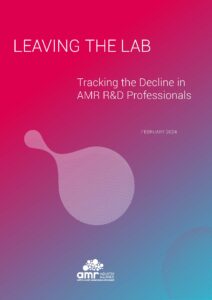Mediaroom
Leaving the Lab: Tracking the Decline in AMR R&D Professionals
 The AMR Industry Alliance conducted a review of publicly available data on the state of AMR research and development talent. It found that:
The AMR Industry Alliance conducted a review of publicly available data on the state of AMR research and development talent. It found that:
- The AMR R&D workforce is limited and declining. It estimates approximately 3,000 AMR researchers currently active in the world, compared to as many as 46,000 for cancer and 5,000 for HIV/AIDS.
- AMR research output is many times lower than fields like cancer and HIV/AID. In 2022, there were 35 times more papers published on cancer than priority bacteria, with 20 times more patents awarded for cancer than antibiotics.
- The AMR R&D workforce has significantly declined over the past two decades. The total number of authors on all AMR publications declined from a high of 3,599 in 1995 to just 1,827 in 2020.
The report finds that major pharmaceutical companies and smaller biotech companies alike have struggled with a lack of market incentives, while private investors and governments have directed funds to other disease areas. This disturbing trend has been exacerbated by the broken market for antimicrobials, a lack of investment in the field, and loss of expertise due to job changes and retirements. To counter this, the report concludes:
- Adequate funding for push and pull incentives can play a key role in addressing low funding. If we are to meet the need for new antimicrobials, we must invest in the people who are responsible for their discovery.
- Continue catalyzing new scientists and galvanizing groundbreaking AMR research by introducing scientists to AMR, as demonstrated by organizations like ICARe and Future Leaders Against AMR.
- New investments are needed to help more physicians overcome the financial barriers to entering infectious disease – which typically costs aspiring doctors more while yielding less income.
date
08/02/2024
